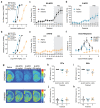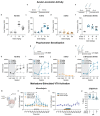This is a preprint.
Unique pharmacodynamic properties and low abuse liability of the μ-opioid receptor ligand (S)-methadone
- PMID: 36993715
- PMCID: PMC10055532
- DOI: 10.21203/rs.3.rs-2644719/v1
Unique pharmacodynamic properties and low abuse liability of the μ-opioid receptor ligand (S)-methadone
Update in
-
Unique pharmacodynamic properties and low abuse liability of the µ-opioid receptor ligand (S)-methadone.Mol Psychiatry. 2024 Mar;29(3):624-632. doi: 10.1038/s41380-023-02353-z. Epub 2023 Dec 25. Mol Psychiatry. 2024. PMID: 38145984 Free PMC article.
Abstract
(R,S)-methadone ((R,S)-MTD) is a racemic μ-opioid receptor (MOR) agonist comprised of (R)-MTD and (S)-MTD enantiomers used for the treatment of opioid use disorder (OUD) and pain. (R)-MTD is used as an OUD treatment, has high MOR potency, and is believed to mediate (R,S)-MTD's therapeutic efficacy. (S)-MTD is in clinical development as an antidepressant and is considered an N-methyl-D-aspartate receptor (NMDAR) antagonist. In opposition to this purported mechanism of action, we found that (S)-MTD does not occupy NMDARs in vivo in rats. Instead, (S)-MTD produced MOR occupancy and induced analgesia with similar efficacy as (R)-MTD. Unlike (R)-MTD, (S)-MTD was not self-administered and failed to increase locomotion or extracellular dopamine levels indicating low abuse liability. Moreover, (S)-MTD antagonized the effects of (R)-MTD in vivo and exhibited unique pharmacodynamic properties, distinct from those of (R)-MTD. Specifically, (S)-MTD acted as a MOR partial agonist with a specific loss of efficacy at the MOR-galanin 1 receptor (Gal1R) heteromer, a key mediator of the dopaminergic effects of opioids. In sum, we report novel and unique pharmacodynamic properties of (S)-MTD that are relevant to its potential mechanism of action and therapeutic use, as well as those of (R,S)-MTD.
Keywords: NMDAR; computational model; opioid.
Conflict of interest statement
MM has received research funding from AstraZeneca, Redpin Therapeutics, and Attune Neurosciences. Dr. Zarate is a full-time U.S government employee. He is listed as a coinventor on a patent for the use of ketamine in major depression and suicidal ideation. Dr. Zarate is listed as a coinventor on a patent for the use of (2R,6R)-hydroxynorketamine, (S)-dehydronorketamine and other stereoisomeric dehydro and hydroxylated metabolites of (R,S)-ketamine metabolites in the treatment of depression and neuropathic pain. Dr. Zarate is listed as co-inventor on a patent application for the use of (2R,6R)-hydroxynorketamine and (2S,6S)-hydroxynorketamine in the treatment of depression, anxiety, anhedonia, suicidal ideation and post-traumatic stress disorders. Dr. Zarate has assigned his patent rights to the U.S. government but will share a percentage of any royalties that may be received by the government.
Figures




References
Publication types
Grants and funding
LinkOut - more resources
Full Text Sources
Research Materials

